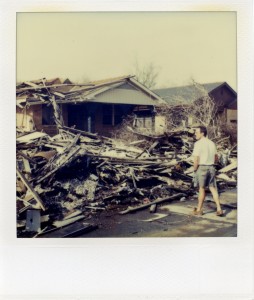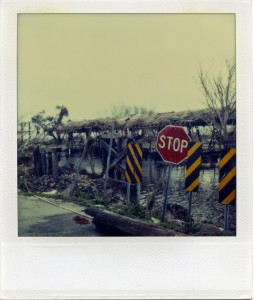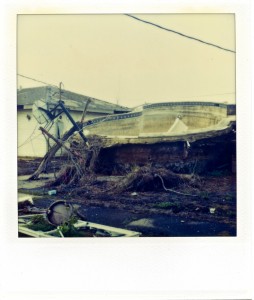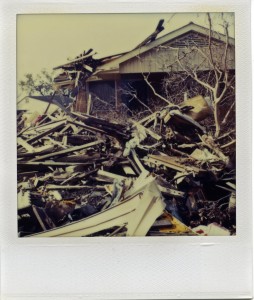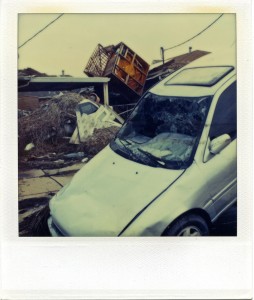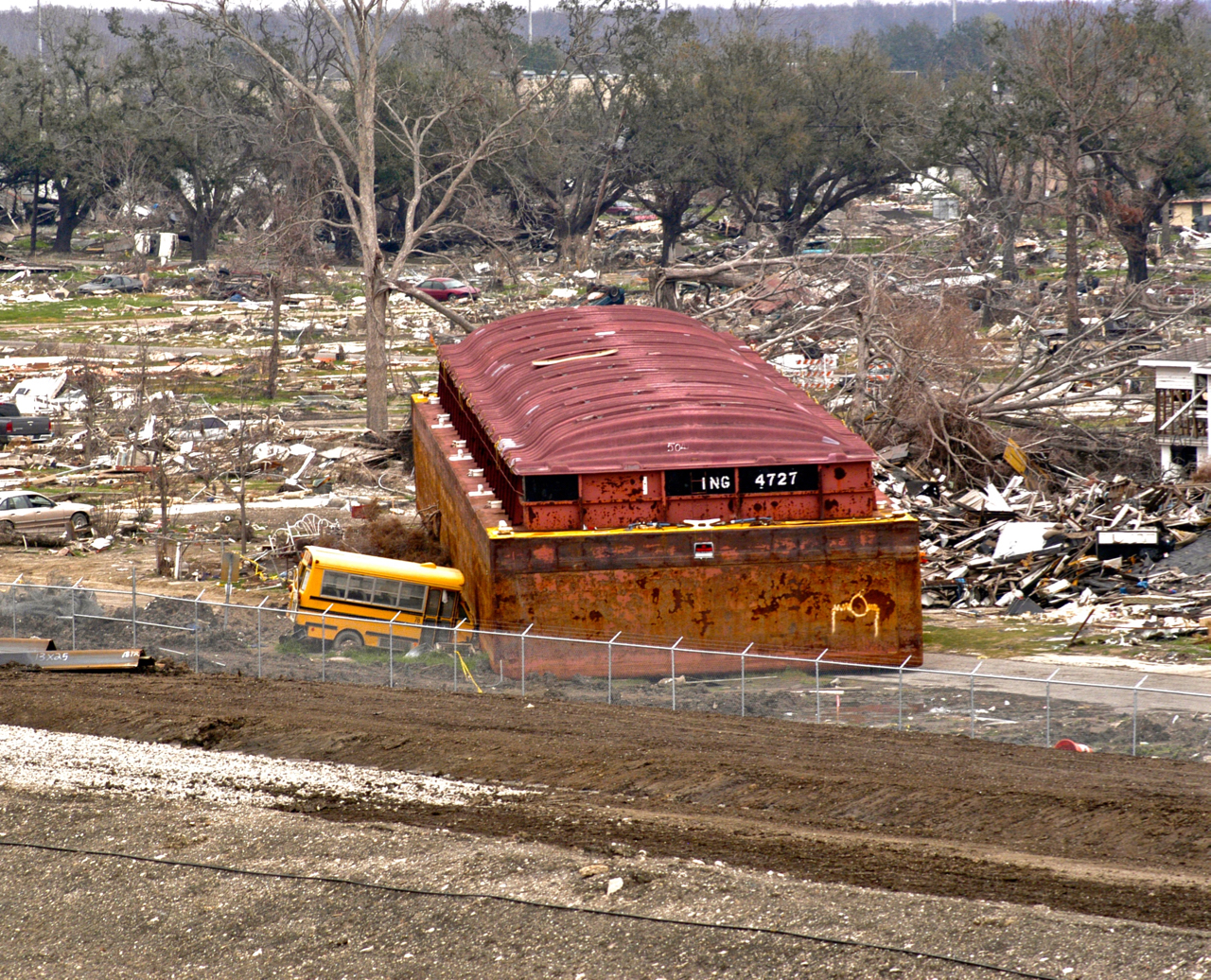
29 Aug The Chocolate City Report, Part the Second
Coming to you from a coffee house on Magazine where all the young hipster/slacker/yuppie-types (plus the occasional old fart like myself) hang out and surf the internet on the free wifi. One thing I’ll say for the City That Forgot to Care, it still has its share of fabulous babes. I see more attractive women in this place in any given hour than I do in Santa Fe in an entire week. But then I don’t get out much. Makes me pine for the olde dump—this dump, that is—a bit.
Yesterday was the day that your intrepid reporter girded his loins, loaded his Polaroid SX-70, grabbed his brand new Casio digital, and set forth upon the Grand Tour. The expedition was led by the Commodore his own self with the invaluable aid and moral support of Brother Danny Dog. I had dinner with Brother D and Nona and the kids on Saturday night—the Commodore was supposed to be in attendance but was suffering from a severe case of alcohol poisoning from the exertions of the two previous evenings and was unable to muster much more than a groan down the beleaguered phone lines from Jefferson Parish. Down for the count.
Danny and Nona’s fab joint got through the what the Commodore refers to as ‘The Difficulties’ [the Troubles having already been claimed by Northern Ireland] exceptionally well—no structural damage, just a dead refrigerator, no neighborhood amenities available yet (gas, food, Hubig’s pies, BEER), and persistent power outages. Amazingly, they had no serious flooding on their immediate block even though Bayou St. John, right outside the front door, still looks menacingly high four-plus months later. Apparently the other side of the bayou is lower and people just a couple of hundred yards away had two and three feet of water. Danny & Nona were awaiting the delivery of a new fridge on Sunday but for the time being all meals were coming out of a bunch of coolers on the porch. Danny said that they had real reservations about coming back from Austin but they finally decided that they needed to give the old whore one more roll in the hay to see if there was anything left after the recent debacle. The kids are resilient as hell and seemed to be dealing with it all very well, as long as there was some structure in their days. Things is very quiet out on the bayou and, contrary to other reports, the legendary Moss Hotel (the Chelsea Hotel of Mid-City) has managed to hold its own. It lost most of the roof but is being repaired and looks not much worse for the wear & tear. She will live to breed fleas the size of cockroaches and cockroaches the size of mice (and mice the size of rats, rats the size of cats, etc, etc) again.
The Commodore picked me up on St. Charles about 9:45 in front of the folks’ place and we drove out to the bayou and got Danny. I had already toured the Lakefront and so had D, so the Commodore steered us out southeastwards from the city, heading down through St. Bernard Parish in the direction of Plaquemines. The Commodore knows this part of the world like the back of his hand—he estimates that he has been up and down nearly every street in the city since The Difficulties and knows the boonies intimately from his 23 years on the job with the Department of Wildlife and Fisheries. Danny and I had only a vague notion of exactly where we going and how were getting there but we knew that in the capable hands of the Commodore we would experience nary a false move.
We bypassed the Lower Ninth, leaving the best/worst for last and headed out highway 46 through Arabi, Chalmette, Reggio and other little burgs in the direction of a spot called The End of the World, which is where the road pretty much ends at a bunch of fishing camps and docks. [There are a few different spots that claim the unofficial title of ‘The End of the World’ in southern Louisiana. The best known is the locale of Boothville-Venice on highway 23, across the Mississippi River from our actual location.] The Commodore knows people who live all over this area and he kept pointing out trashed houses and homesites where there was nothing more than a slab and a bathtub left, saying ‘That’s where so-and-so lived—good people. They’re gone.’ This area was largely under 20-plus feet of water. As opposed to the devastation in Orleans Parish, it was the tidal surge from Lake Borgne and the Gulf that caused the destruction. There is NOTHING, not a SINGLE THING, in this entire area, which we drove through for about two hours, that isn’t totally shitcanned.
The scene is much more like what happened on the Mississippi Gulf Coast than what went down in New Orleans, since the water didn’t stick around: It rose up, pushed by the storm, surged through the area, flattened, fucked up and washed away EVERYTHING and then flowed back out. The camps along the bayou were generally nothing but pilings on top of which just about every one a pelican sat. There were cars and trucks submerged in the water, nothing but tailgates and rear wheels or tops of roofs sticking out. There were boats in trees, boats sunk in the bayou, boats upside down on the road. Houses and camps that were built up on pilings were trashed by the wind and the Commodore said that someone told him that a wind gauge located somewhere down in this area registered speeds of 200 mph before it broke down.
Highway 39 is a two-lane and it’s miraculous that it’s still there as it has been severely undercut and was down to one lane in numerous areas. There were FEMA crews out there picking around in the rubble and, as with the devastation everywhere in the area, it seemed almost ridiculous. Apparently the heavy lifting to clear the highway had taken place a while back, but that was about the extent of it. Off the road, everything looked as if the hurricane had hit a day or two before. Every now and then we’d come along one of these crews in haz-mat suits, wandering around the edge of the highway. I said ‘What are they doing? What are they looking for?’ The Commodore said these guys were just searching for hazardous materials like butane tanks and gas cans and oil drums and stuff like that since it was obvious they weren’t equipped to handle anything bigger than what they could fit in the back of a pickup truck. It had a surreal quality to it—a Sisyphean task of the most epic proportions—and the further we went the harder it became for me to imagine how any of this region would ever get back on its feet again. It really is overwhelming and it represents a whole way of life—a culture of fishing and hunting—that has taken a massive hit from which it may never recover. Apparently, since the storm the fishing has been excellent but the camps and the nets and the boats and the docks are all gone. On the other hand, crawfish populations apparently got hammered and today’s Times-Picayune said that the price per pound had doubled since The Difficulties. The horror, the horror…
We stopped at a couple of points to take pictures but my digital camera came without a memory card (I didn’t even realize that I needed one!) and all I could handle was three shots before the built in memory was full up. I just bought a card for it but I probably won’t have one with significant capacity until I get back home. One sight that Danny and I goggled over was a sort of post-modern quonset hut that some far-sighted individual had put up on pilings about 20 feet off the ground. It was quite new and was literally about the only undamaged structure that we encountered on the entire trip. I did manage to get a photo of that and will try to attach it.
On highway 300 at Delacroix we came to a dead end where there was a long structure that looked to have been a boat shed of some kind. It was like a sort of elongated thatched hut—the roof was entirely covered with what appeared to be palm frond thatching. What it really was was a covering of dried out marsh grass. The roof of the structure was about 15-plus feet above the ground and the water from the storm surge had washed entirely over it. There was mile after mile after mile of this.
There were some people out fishing—the Commodore said ‘What else are they going to do?’—and some folks picking around in the rubble of what had been their homes or camps. People crawling around by the side of the road on piles of trashed-out everything, 20 to 25 feet high. God knows what they were looking for or expecting to find. There is essentially nothing in this part of the state that would seem to be salvageable and we drove through it for hours. We stopped to take photos at one point and when we got back in the Commodore’s truck we discovered that it had filled up with giant swamp mosquitoes. They swarmed all over you in seconds outside and we had to kill all the bastards that got into the truck before we could do anything else—there were a couple dozen in there at least. Finally the Commodore opened up all the windows and sped up to about 65 to blow them all out.
We headed back towards the city and drove up and down through Chalmette, where the flood had been up to the roof tops—this from the Industrial Canal breach. It was enough in Chalmette to float some houses off their foundations, collapse others, and provide most houses with a festive fringe of swamp grass. The Commodore said that at one house a deer floundering around in the flood waters had managed to climb up on a rooftop and had spent the deluge stranded up there along with an alligator. One house had an in-ground swimming pool that the water pressure had popped totally up out of the ground, 100% intact, leaving a kidney-bean shaped hole in the ground in the back yard.
The streets were still totally lined with giant piles of trash—people’s belongings, sheetrock, carpeting—everything in big soggy disgusting heaps everywhere you went down every street. There was hardly any traffic at all and the FEMA crews and private contractors eyed us suspiciously as we drove through. There were cops here and there keeping an eye on things but generally speaking the streets were deserted. We stopped at one point to take a leak and did so in the middle of the street without having to think anything about it.
The coup de grace—the Gold Standard of Mayhem—was, is, and will probably be for all time, the Lower Ninth. The area from Florida Avenue south to the Mississippi and west of the St. Bernard Parish line is the epicenter of destruction and no matter what you have seen on the net or read or seen on the tube, nothing can quite prepare you for the scene as it really is. The Hiroshima of The Difficulties. The water pressure surging through the breach in the Industrial Canal levee was massive and the Lower 9th took it in the teeth. As the Commodore put it, they took an ass whuppin’. It literally looks like the place was leveled by an atomic blast and, but for the lack of radiation (so far as we know), that’s pretty much how it really is.
There is one house, covered with blue tarps, that remained more or less on its foundations that has been taken over by some carpetbaggers from parts north and west that has turned into the center of the ‘No Bulldozing’ ‘Return to the Lower 9th’ campaign. They had signs posted all around the house that said stuff like ‘People Live In These Houses’ and such. Well, actually, no they don’t. They ain’t nobody home right now. And if they was, they shouldn’t be. That entire neighborhood—how many square blocks/acres?—is beyond fucked, and who knows what kind of toxic shit has permeated every molecule in the entire region? Perhaps the only thing to do is to bulldoze the entire thing and let the swamps have it back. If you cleared it all out and started rebuilding tomorrow I’d think you’d have to be insane to want to live there. There are petroleum refineries and chemical plants and who knows what the fuck else all up and down the river in that area and I wouldn’t live in a mansion in that joint if you paid me. As of right now the only thing that has been done is for the streets to be more or less cleared (except for the streets that have houses sitting in the middle of them) and the more obvious hazardous materials carted away. Other than that, the Lower Ninth sits stewing its own juices, pretty much exactly the way it has been since late August.
On the other hand, the Lower Ninth has become a major tourist destination and in addition to our hardy crew there were busloads of people cruising around and dozens of others on foot, wandering around with cameras and video equipment, looking simultaneously stunned and thrilled. The giant barge that washed through the breach in the levee remains where it has been since August with the school bus crunched beneath it—a monument to the mind boggling scale of the mayhem. I was wondering what would happen with the thing. It’s obviously way too big to get back over the levee and into the Industrial Canal. Way way too big to fit onto even the biggest truck. They’ll either have to cut it up with torches and cart it away or just leave it where it is.
On the west side of the canal the Desire Projects and the Upper Ninth and Seventh Wards are pretty much ghost towns. Dey’s rich folks in there too what got they ass whupped along with everybody else, but no matter what common sense might tell you, The Difficulties are being spun as a racial issue. However, despite the democratic hand of nature, if what happened here had happened in, say, Santa Barbara, do you think the administration would have just stood by, watching for days on end, saying ‘Oh my goodness, this is a regrettable situation indeed!’ If the perception were that there was a bunch of rich white folks whose shit was getting clobbered and washed away, as opposed to a bunch of po’ colored folks, would things have played out this way? But of course the levee breaches and flood wall failures were not the result of the democratic hand of nature. Either way, Nagin really fucked himself with his Chocolate City maunderings. It is a prime topic of discussion and grim humor amongst the white population. The advent of Chocolate City might be the last nail in the coffin for more than a few people who might have harbored some hope about the future of the city. Nagin has no credibility left with anybody at this point. He was the black mayor that the white folks felt comfortable with because he was a businessman, a corporate executive. The whole MLK Day hallucination seems to have been some sort of desperate ploy to try and court support from the black community. Needless to say, they wasn’t buying what C. Ray was selling. You’d think that the mayor’s handlers would try to keep him off the mescaline before lunchtime.
There is a lot of divisive rhetoric in Chocolate City right now. Almost everything I’ve heard from the people I’ve talked to in the city who feel free to talk openly characterize the situation in terms of Us and Them. ‘They’ and ‘Them’ are the pronouns used by just about every white person who would otherwise be hesitant to resort to the word ‘niggers,’ but the sentiment is pretty much the same regardless of the terminology. The projects are empty and either flapping wide open or locked down using some sort of high-tech Scandinavian-made metal grilles over the doors and windows emblazoned with the brand name ‘ACCESS DENIED.’ In turn, the Commodore says that the crime rate in Houston has spiked 20% or something and the murder rate was up 70% or something (or was it the other way around, Danny?).
In summary, the devastation is not just a few neighborhoods, and not just the city, and not just the greater NO area—it is the Region. From Galveston all the way to the Alabama border, the Gulf Coast has had its ass stomped in a cold blooded fashion. The scale of it challenges comprehension and I really can’t imagine how the city, the greater NO area and beyond, will ever rebound fully from this. It is too much. And without really creative, intelligent, clear-headed, far-sighted leadership to speak some hard truths, work on some healing, and lead the way to the future I just cannot see how things will ever come back. But, quite frankly, that’s most likely a good thing. New Orleans has been so fucked up for so long, the only way through to some kind of positive change may be to wipe the slate clean and start over. But that’s a tall order and the person who might yet rise above the bullshit and do the right thing for the people does not—yet—seem to be present and accounted for. And this comes from an incurable optimist.
Over & out,
DC


